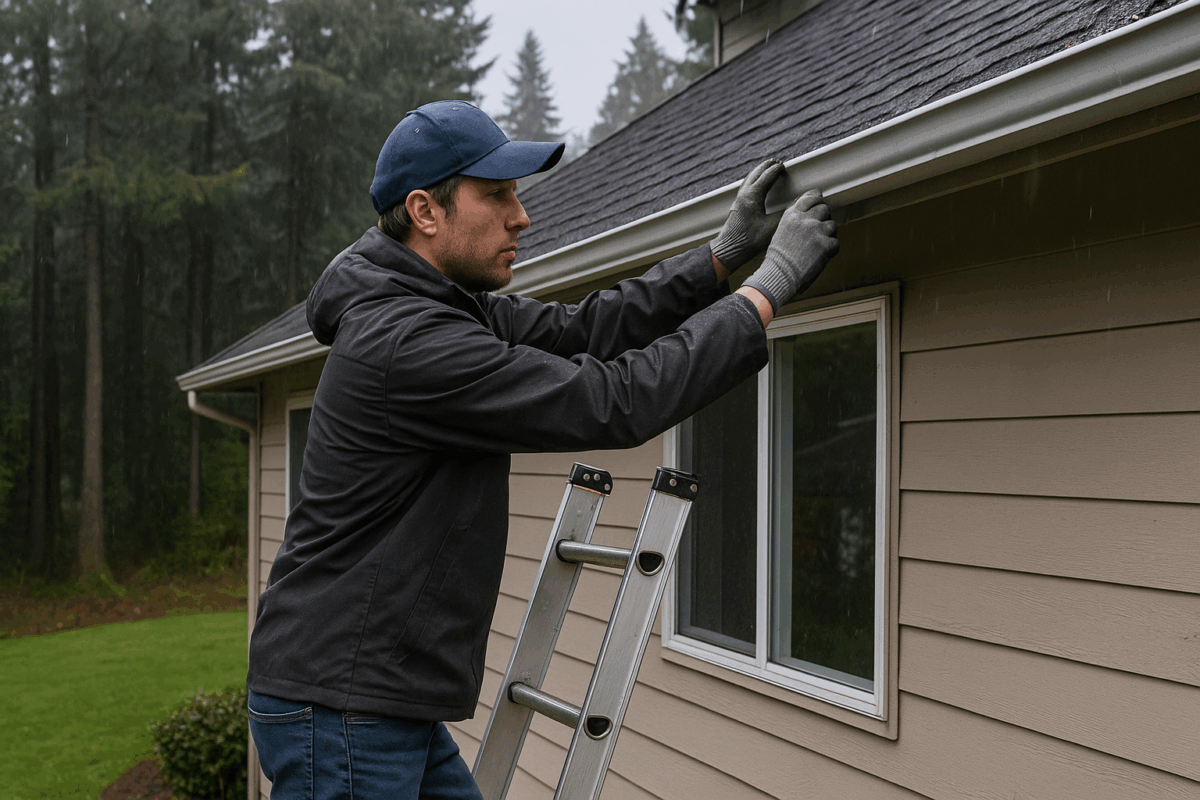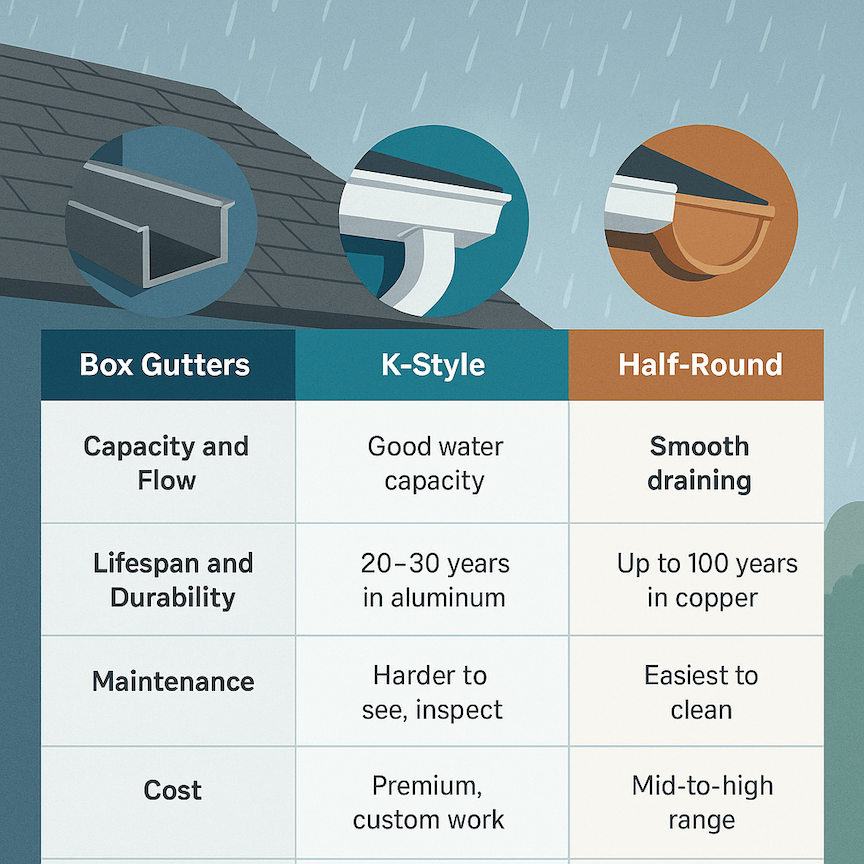Washington homeowners know wind season is not just a noisy inconvenience. Strong gusts roll in from the Pacific, push through mountain gaps, and sweep across towns with surprising force.
Some years feel especially intense, with the National Weather Service in Spokane reporting straight-line winds that can top 100 mph. When storms get more frequent (NOAA shows the U.S. has jumped from an average of $9 billion in disasters per year to more than $27 billion recently), small parts of a home’s exterior start to show the strain.
Gutters sit right at that intersection of wind, rain, and debris. When they loosen or detach, water goes exactly where it should not.
This guide walks through why wind affects gutters so directly, what usually fails first, and how a few smart upgrades can protect your home before the next round of storms hits.
Why Washington’s Windstorms Create the Perfect Conditions for Gutter Failure
Washington’s windstorms have a pattern. They hit during fall and winter, usually with colder fronts or downbursts. Those downbursts drop air fast, and when that air hits the ground, it spreads horizontally with a force that can lift and shake anything attached to a roofline. That includes gutters that are carrying water or debris. Gusts push, tug, and rattle.
- Wind Uplift: Wind flowing under the gutter edge creates a lifting force. If a fastener is already loose, that small motion becomes a bigger gap with each storm.
- Side Pressure: Sideways gusts shake the entire run. Over time, that movement weakens brackets and nails, especially on older homes with aging fascia.
- Storm Frequency: More frequent severe weather across the U.S. and Washington’s geography leaves many communities exposed. That means gutters take more hits each year than they used to.
All of this helps explain why rain gutter repair is becoming routine after wind events. In a state where storms come back year after year, even new systems need the right layout and hardware to stay secure.
How Improper Installation and Aging Systems Fail First
Some gutters survive wind with barely a wobble. Others start pulling away after one rough week. The difference usually comes down to how the system was installed and how old the supporting materials are.
- Spacing Problems: Hangers spaced too far apart let long sections sag under weight, and windy weather stretches those areas even further, eventually pulling the gutter out of line.
- Fastener Issues: Spikes look sturdy, but they work loose over time. Screws hold far better, especially when they reach into the roof framing rather than just fascia boards.
- Fascia Rot: Moisture behind old gutters can soften fascia. Once the wood loses strength, no hanger can properly grab it.
- Seam Failures: Sectional gutters have multiple joints. Those seams catch wind and shift, making the entire run more vulnerable.
Gutters need uplift-rated hardware, closer fastener spacing, and proper anchoring behind flashing. When systems lack these basics, even moderate storms can start pulling metal away from the roof edge.
It’s one of the reasons homeowners eventually need gutter replacement or updated hardware, even if the gutters themselves still look good. This is also where seamless gutters installation makes a real difference. Fewer seams mean fewer weak points.
How Wind + Water + Debris Create a Cascade of Structural Problems
Wind alone is tough on gutters, but the real trouble often appears when wind combines with other forces. Washington’s long rainy season fills gutters quickly, and debris from evergreens adds sudden weight. When the temperature drops, ice forms, and that weight multiplies.
- Clogs create standing water: Water trapped in one section becomes heavy enough to bend metal downward.
- Ice locks gutters into a fixed position: When wind hits a frozen, overloaded run, the system can’t flex. Something gives, usually a bracket.
A poor slope keeps water from draining: That trapped water strains the fasteners during storms. - Downspout blockages push water back: The pressure stays near the roofline, where wind hits hardest.
This mix explains why national insurance data shows that wind and hail account for 34–42% of recent homeowners’ claims. Once a gutter shifts, water has a direct path behind siding or toward the foundation. That’s why homeowners often search for downspout repair services near them after wind events, as downspouts take hits almost as often as the gutters themselves.
The Real Consequences When Gutters Detach in Washington
The moment gutters detach, even slightly, the system stops doing its job. Water spills where it shouldn’t, and it only takes one storm for the damage to spread.
Water Damage
Rain can flow behind siding and soak wall cavities. Over time, that moisture invites mold and damages insulation.
Foundation Issues
Overflowing gutters dump water directly along the base of the house. Soil saturates, concrete shifts, and small cracks grow.
Insurance Exposure
When homeowners file wind-related claims, premiums often rise. With years like 2024 producing 27 billion-dollar disasters nationwide, insurers watch loss patterns closely. That matters because a simple gutter replacement costs far less than repairing water-damaged walls or filing a claim.
Proven Prevention Steps to Keep Gutters Secure in High Winds
Fixing damage after a storm is doable, but avoiding it in the first place saves a lot of stress. Washington homes stay safer when a few small habits become routine.
A continuous gutter run has fewer weak spots, so seamless gutter installation often holds up better in strong winds. Some people close the gap between hangers to spread the strain. Others shift to uplift-rated fasteners because they grip tighter and stay put when older hardware starts to loosen.
Seasonal cleaning also matters, primarily when debris collects near the roof edges. Strong anchors help downspouts stay put during gusty weather, which makes downspout repair less likely after rough storms. Checking the slope once things calm down keeps small shifts from turning into bigger repairs.
Protect Your Home by Working With Washington’s Gutter Wind-Damage Specialists
After reading through the mechanics of wind damage, you can see why gutters rarely fail at random. They respond to how they were installed, how often they are maintained, and how well they can handle Washington’s storm cycles.
At Gutter Empire LLC, we approach every project with that context in mind. We secure failing hardware, reinforce weak points, repair downspouts, and replace old systems with durable options built for high-wind areas. If you need gutter repair solutions near you, we are ready to help. Contact us at (971) 777-9899, or click here for a free estimate.



